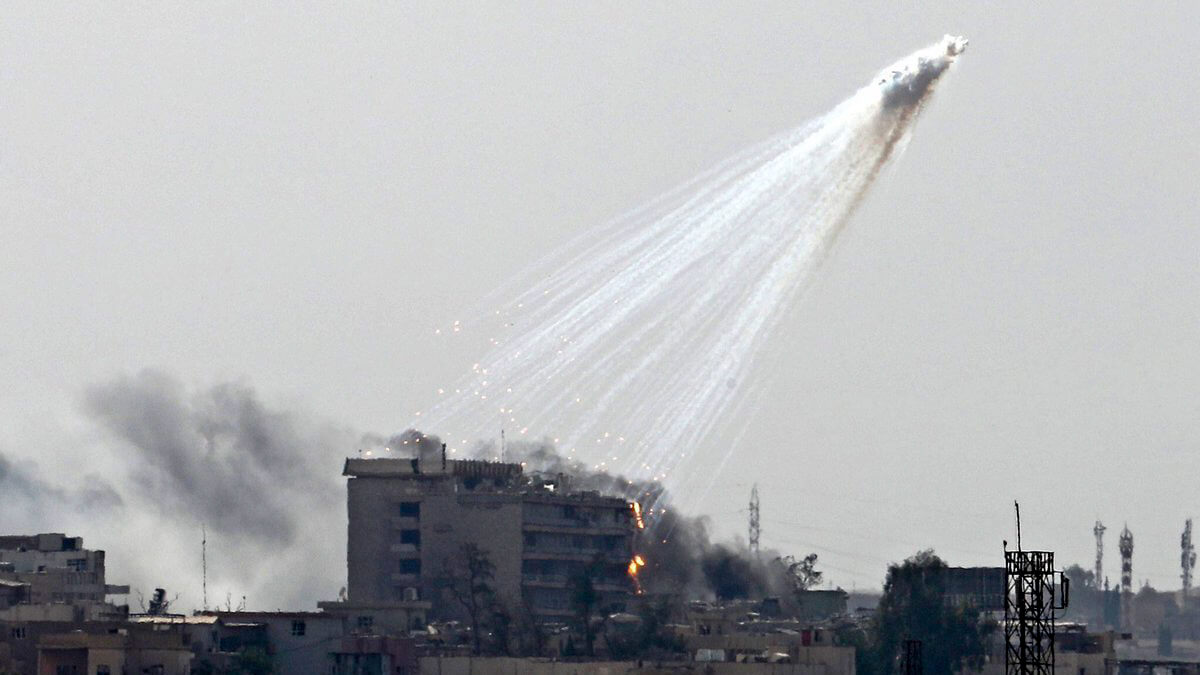Whitney Webb @_whitneywebb  DEIR EZ ZOR, SYRIA – The U.S.-led coalition in Syria has been accused of using white phosphorus incendiary munitions for the fourth time since mid-September. White phosphorus is banned internationally when used in areas with civilian populations.
DEIR EZ ZOR, SYRIA – The U.S.-led coalition in Syria has been accused of using white phosphorus incendiary munitions for the fourth time since mid-September. White phosphorus is banned internationally when used in areas with civilian populations.
Syrian state news agency SANA reported on a bombing conducted by the U.S.-led coalition that had targeted the small city of Hajin in Syria’s Eastern Deir Ez-Zor province over the weekend. The bombing, allegedly intended to target Daesh (ISIS) terrorists who control the city, killed fifteen civilians – among them women and children – and injured scores more. Civil sources cited by SANA reported that white phosphorus bombs had been used, which – in addition to resulting in several civilian deaths and injuries — caused massive property damage due to the fires resulting from the use of the banned substance.
White phosphorus is well-known for igniting spontaneously in the presence of oxygen and its use frequently results in post-explosion fires that can burn for hours, as well as painful chemical burns for those who come in contact with the substance, which can stick to hair and clothing. The International Committee of the Red Cross has stated that “employing asphyxiating, poisonous or other gases, and all analogous liquids, materials or devices is listed in the Statute of the International Criminal Court as a war crime.”
As a result of the extreme damage it can cause, Protocol III of the 1980 Convention on Conventional Weapons prohibits the use of the chemical weapon in areas populated by civilians. However, the United States is not a signatory of Protocol III.
The recent alleged bombing of a Syrian town with white phosphorus by munitions is the fourth time the U.S.-led coalition has been accused of using the banned substance in the village of Hajin just since September. On Oct. 29, and a few weeks prior on Oct. 13, local sources reported the use of white phosphorus by coalition jets in Hajin. A month prior, on Sept. 10, Russia’s military mission in Syria also accused the U.S. coalition of using white phosphorus munitions in the city of Hajin.
The prior bombings were the result of an effort of by the United States’ military’s proxy in Syria, the Syrian Democratic Forces (SDF), to take the city of Hajin from Daesh. However, the SDF suspended its campaign to take Hajin at the end of October, three days before this most recent bombing. Notably, Hajin is the site of an important Syrian oil refinery, making it an area of interest to the U.S.-led coalition, which is currently occupying 30% of Syria as well as the areas containing the vast majority of the country’s oil resources.
Seeking Justification for War Crimes
Unfortunately, the U.S.-led coalition has been using white phosphorus in combat operations long before September. In fact, the use of white phosphorus had become so commonplace that a New Zealand general that worked with the coalition openly admitted to its use in Iraq’s Mosul in an interview with NPR. The coalition also used the banned munitions in its efforts to take the Syrian city of Raqqa from Daesh in June of last year.
Those two offenses, which took place in areas that were densely populated by civilians, prompted groups like Human Rights Watch (HRW) to slam the U.S.-led coalition for putting civilians in Raqqa and Mosul at unnecessary risk.
“No matter how white phosphorus is used, it poses a high risk of horrific and long-lasting harm in crowded cities like [Syria’s] Raqqa and [Iraq’s] Mosul and any other areas with concentrations of civilians,” Steve Goose, the arms director at the HRW, had stated last June.
At the time, a spokesman for the U.S.-led coalition claimed that the U.S. military only used white phosphorus in “accordance with the law of armed conflict” and that the munitions were only “used for screening, obscuring, and marking in a way that fully considers the possible incidental effects on civilians and civilian structures.”
Thousands of civilians died in coalition efforts to retake Raqqa, which also destroyed an estimated 90% of the buildings in the city. Over a year after the operation concluded, many of the dead are still buried under the rubble. This past June, Amnesty International accused the U.S. coalition of “war crimes” in its Raqqa offensive.
Top Photo | This image from Human Rights Watch shows the alleged use of white phosphorus by the US coalition in Syria and Iraq. Photo | HRW
Whitney Webb is a staff writer for MintPress News and a contributor to Ben Swann’s Truth in Media. Her work has appeared on Global Research, the Ron Paul Institute and 21st Century Wire, among others. She has also made radio and TV appearances on RT and Sputnik. She currently lives with her family in southern Chile.